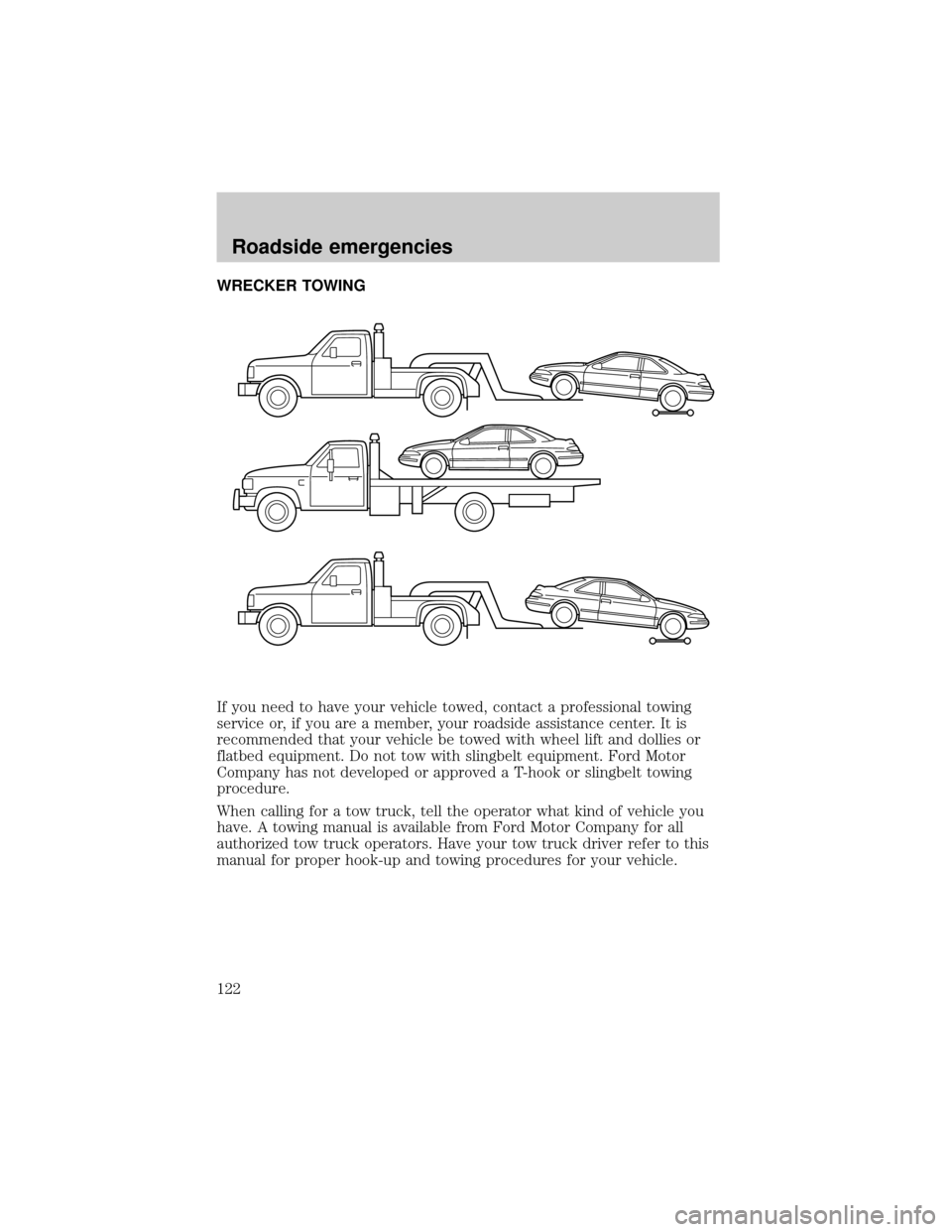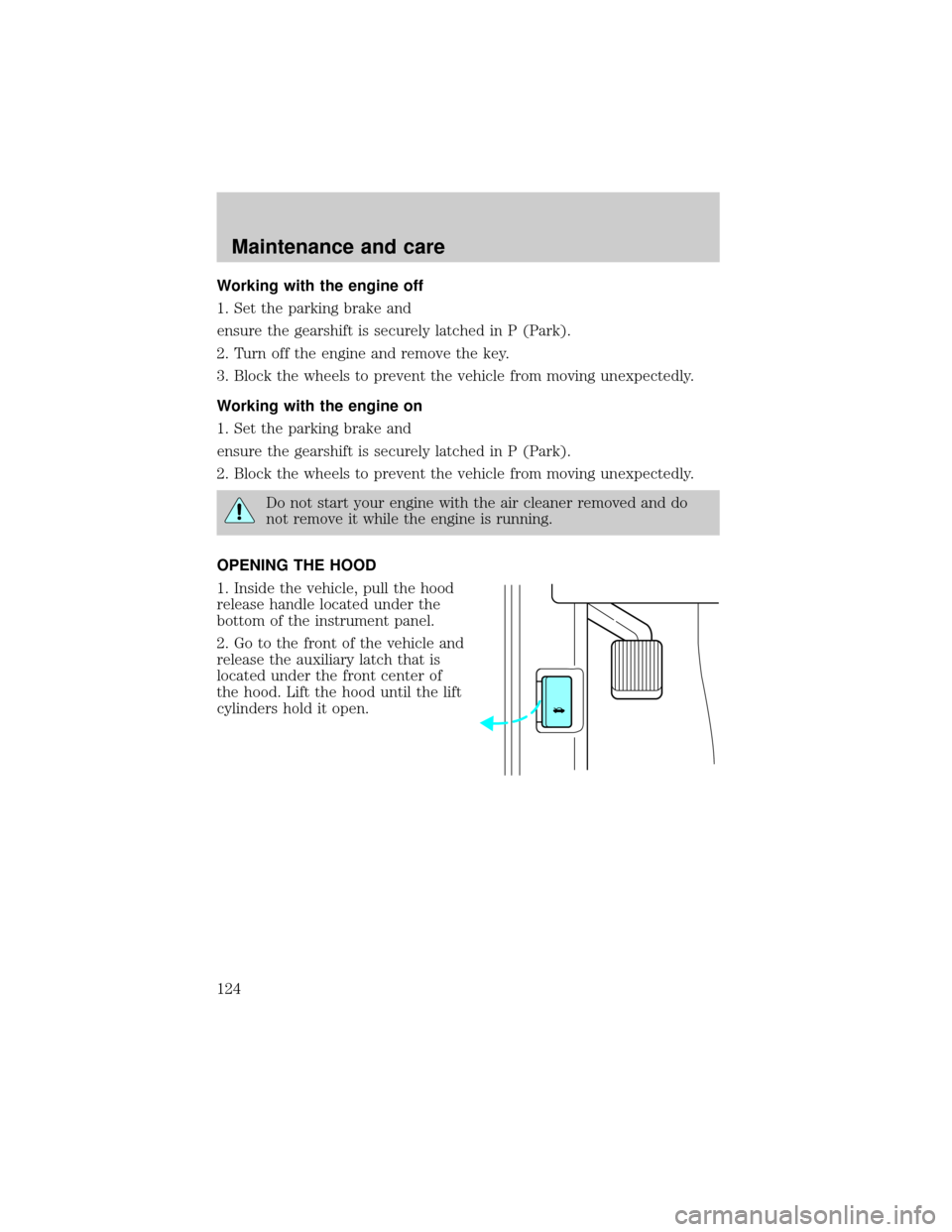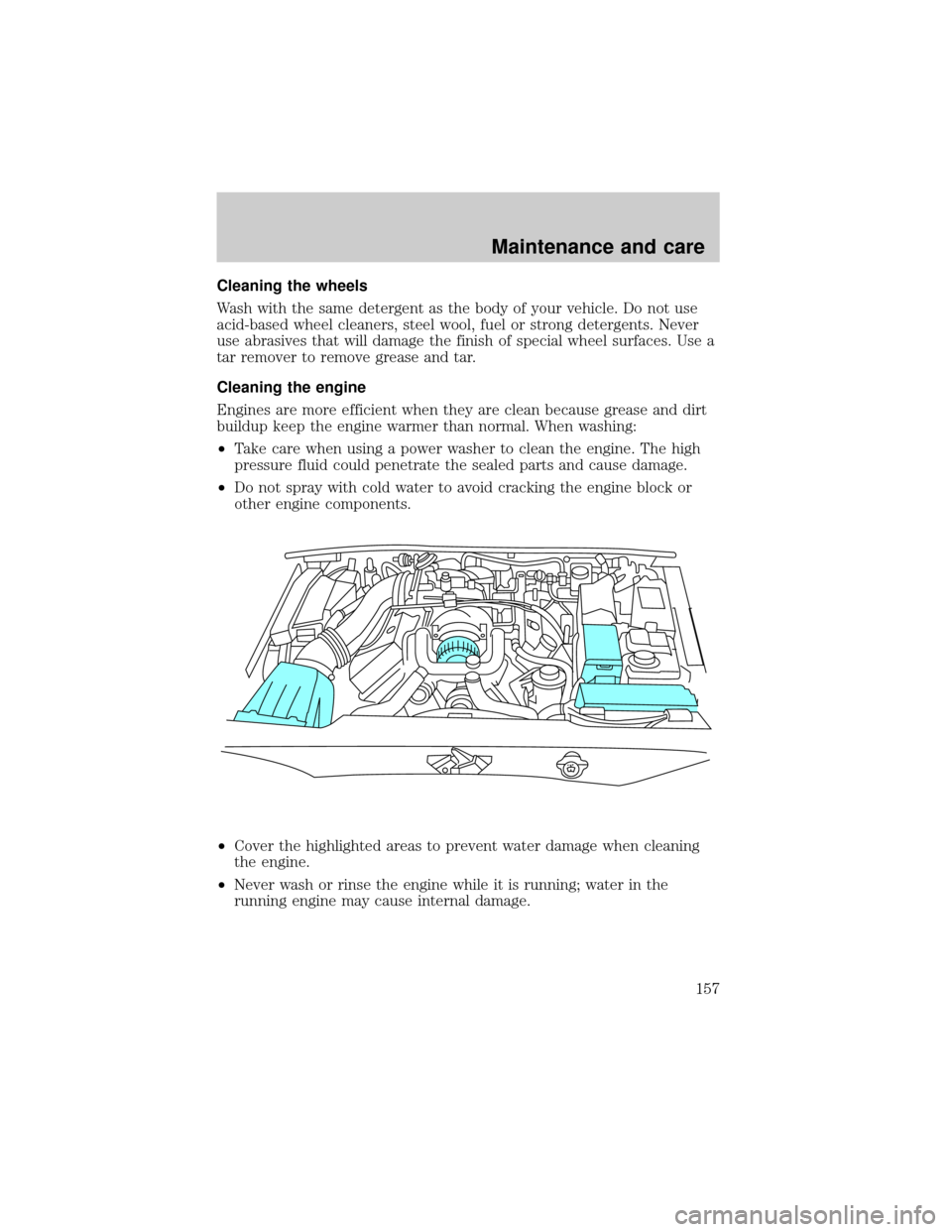1998 LINCOLN MARK VIII wheel
[x] Cancel search: wheelPage 121 of 170

WRECKER TOWING
If you need to have your vehicle towed, contact a professional towing
service or, if you are a member, your roadside assistance center. It is
recommended that your vehicle be towed with wheel lift and dollies or
flatbed equipment. Do not tow with slingbelt equipment. Ford Motor
Company has not developed or approved a T-hook or slingbelt towing
procedure.
When calling for a tow truck, tell the operator what kind of vehicle you
have. A towing manual is available from Ford Motor Company for all
authorized tow truck operators. Have your tow truck driver refer to this
manual for proper hook-up and towing procedures for your vehicle.
Roadside emergencies
122
Page 123 of 170

Working with the engine off
1. Set the parking brake and
ensure the gearshift is securely latched in P (Park).
2. Turn off the engine and remove the key.
3. Block the wheels to prevent the vehicle from moving unexpectedly.
Working with the engine on
1. Set the parking brake and
ensure the gearshift is securely latched in P (Park).
2. Block the wheels to prevent the vehicle from moving unexpectedly.
Do not start your engine with the air cleaner removed and do
not remove it while the engine is running.
OPENING THE HOOD
1. Inside the vehicle, pull the hood
release handle located under the
bottom of the instrument panel.
2. Go to the front of the vehicle and
release the auxiliary latch that is
located under the front center of
the hood. Lift the hood until the lift
cylinders hold it open.
Maintenance and care
124
Page 131 of 170
![LINCOLN MARK VIII 1998 Owners Manual Severe winter climate
If you drive in extremely cold climates (less than ±36ÉC [±34ÉF]), it may
be necessary to increase the coolant concentration above 50%. Refer to
the chart on the coolant cont LINCOLN MARK VIII 1998 Owners Manual Severe winter climate
If you drive in extremely cold climates (less than ±36ÉC [±34ÉF]), it may
be necessary to increase the coolant concentration above 50%. Refer to
the chart on the coolant cont](/manual-img/15/7001/w960_7001-130.png)
Severe winter climate
If you drive in extremely cold climates (less than ±36ÉC [±34ÉF]), it may
be necessary to increase the coolant concentration above 50%. Refer to
the chart on the coolant container to ensure the coolant concentration in
your vehicle is such that the coolant will not freeze at the temperature
level in which you drive during winter months. Never increase the engine
coolant concentration above 60%. Leave a 50/50 mixture of engine
coolant and water in your vehicle year-round in non-extreme climates.
CHECKING AND ADDING POWER STEERING FLUID
Check the power steering fluid at
least twice a year. If adding fluid is
necessary, use only MERCONtAT F
power steering fluid.
1. Start the engine and let it run until it reaches normal operating
temperature (the engine coolant temperature gauge will be near the
center of the NORMAL band).
2. While the engine idles, turn the steering wheel left and right several
times.
3. Turn the engine off.
4. Check the fluid level in the
reservoir. It should be between the
MIN and MAX lines. Do not add
fluid if the level is in this range.
5. If the fluid is low, add fluid in small amounts, continuously checking
the level until it reaches the range between the MIN and MAX lines. Be
sure to put the cap back on the reservoir.
DONOTOVERFILLPOWERSTEERINGFLUID
MAX
MIN
Maintenance and care
132
Page 137 of 170

Treadwear
The treadwear grade is a comparative rating based on the wear rate of
the tire when tested under controlled conditions on a specified
government test course. For example, a tire grade 150 would wear one
and one-half (1 1/2) times as well on the government course as a tire
grade 100. The relative performance of tires depends upon the actual
conditions of their use, however, and may depart significantly from the
norm due to variations in driving habits, service practices, and
differences in road characteristics and climate.
Traction A B C
The traction grades, from highest to lowest are A, B, and C, and they
represent the tire's ability to stop on wet pavement as measured under
test surfaces of asphalt and concrete. A tire marked C may have poor
traction performance.
The traction grade assigned to this tire is based on braking
(straight ahead) traction tests and does not include cornering
(turning) traction.
Temperature A B C
The temperature grades are A (the highest), B, and C, representing the
tire's resistance to the generation of heat and its ability to dissipate heat
when tested under controlled conditions on a specified indoor laboratory
test wheel. Sustained high temperature can cause the material of the tire
to degenerate and reduce tire life, and excessive temperature can lead to
sudden tire failure. The grade C corresponds to a level of performance
which all passenger car tires must meet under the Federal Motor Vehicle
Safety Standard No. 109. Grades B and A represent higher levels of
performance on the laboratory test wheel than the minimum required by
law.
The temperature grade for this tire is established for a tire that
is properly inflated and not overloaded. Excessive speed,
underinflation, or excessive loading, either separately or in
combination, can cause heat buildup and possible tire failure.
Maintenance and care
138
Page 156 of 170

Cleaning the wheels
Wash with the same detergent as the body of your vehicle. Do not use
acid-based wheel cleaners, steel wool, fuel or strong detergents. Never
use abrasives that will damage the finish of special wheel surfaces. Use a
tar remover to remove grease and tar.
Cleaning the engine
Engines are more efficient when they are clean because grease and dirt
buildup keep the engine warmer than normal. When washing:
²Take care when using a power washer to clean the engine. The high
pressure fluid could penetrate the sealed parts and cause damage.
²Do not spray with cold water to avoid cracking the engine block or
other engine components.
²Cover the highlighted areas to prevent water damage when cleaning
the engine.
²Never wash or rinse the engine while it is running; water in the
running engine may cause internal damage.
Maintenance and care
157
Page 163 of 170

ENGINE DATA
Engine 4.6L DOHC engine
Cubic inches 281
Horsepower (except LSC) 280 @ 5750 rpm
Horsepower (LSC) 290 @ 5750 rpm
Torque (except LSC) 285 lb. ft. @ 4500 rpm
Torque (LSC) 290 lb. ft. @ 4500 rpm
Recommended fuel grade 91 octane
Firing order 1-3-7-2-6-5-4-8
Spark plug gap 1.3-1.4 mm (0.052-.056 inch)
Ignition system EDIS
Compression ratio 9.8:1
VEHICLE DIMENSIONS
Vehicle dimensions mm (in)
(1) Overall length 5 263 (207.2)
(2) Overall width 1 900 (74.8)
(3) Overall height 1 361 (53.6)
(4) Wheelbase 2 870 (113.0)
(5) Track - Front 1 565 (61.6)
(5) Track - Rear 1 530 (60.2)
Capacities and specifications
164
Page 167 of 170

Aiming headlamps ....................154
Air bag supplemental restraint
system ..........................................77
and child safety seats ..............78
description ................................77
disposal ......................................81
indicator light ...........................80
passenger air bag .....................79
Air suspension
description ................................97
Anti-lock brake system (ABS)
description ................................93
Anti-theft system ........................63
Battery .......................................135
Brake fluid
checking and adding ..............128
Brakes ..........................................93
anti-lock .....................................93
anti-lock brake system (ABS)
warning light .............................94
fluid, checking and adding ....128
Brake-shift interlock ...................97
Break-in period .............................2
Bulbs, replacing ........................145
specifications ..........................154
Changing a tire .........................115
Child safety seats ........................82
Chime
headlamps on ............................11
Cleaning your vehicle ...............156
engine compartment ..............157
fabric ........................................158
instrument panel ....................158
plastic parts ............................158
safety belts ..............................158
tail lamps .................................158
washing ....................................156
waxing .....................................156
wheels ......................................157
windows ..................................160
woodtone trim ........................160Climate control system
automatic temperature
control ..............34,35,36,37,38,39
Compass, electronic ...............22,23
Controls ..................................57,58
Defrost
rear window ..............................40
Emission control system ..........144
Engine ........................................164
service points ..........................125
Engine block heater ...................91
Engine coolant
checking and adding ..............130
disposal ....................................131
refill capacities ........................131
Engine oil ...........................126,127
changing oil and oil filter .......128
checking and adding .......126,127
Exhaust fumes ............................92
Floor mats ...................................58
Fuel
calculating fuel economy .......143
improving fuel economy ........106
octane rating ...........................142
quality ......................................142
running out of fuel .................143
safety information relating to
automotive fuels .....................141
Fuel gauge ...................................14
Fuel pump shut-off switch .......107
Fuse panels
instrument panel ....................109
power distribution box ...........113
Fuses ...................................108,109
Gauges, Mechanical ....................12
engine coolant temperature
gauge .........................................12
Hazard flashers .........................107
Headlamps ...................................32
daytime running lights .............32
flashing ......................................33
high beam .................................32
Index
168
Page 169 of 170

Speedometer ...............................13
Starting your vehicle .............88,91
Sunvisor .......................................51
Tachometer
mechanical cluster ...................13
Tilt steering wheel ......................42
Tires ....................................137,139
changing ..................................115
checking the pressure ............139
replacing ..................................140
rotating ....................................139
snow tires and chains ............140
treadwear ................................138
Traction control ..........................96
active light ..................................7
check traction control
message ................................25,31
how to enable/disable ..............15
off light ......................................11
Trailer towing ............................104
tips ...........................................106
Transmission .............................133
automatic
operation ...........97,98,99,100,102
fluid, checking and
adding (automatic) ................133Trunk
using the remote entry
system to open .........................59
Turn signal
lever ...........................................41
Universal transmitter ..................47
erasing channels .......................50
operating ...................................49
programming .............................48
Vehicle dimensions ...................164
Vehicle Identification
Number (VIN) ...........................166
Vehicle loading ..........................103
Ventilating your vehicle .............92
Warning chimes .............................6
Wheels
anti-theft lug nuts ..................118
Windows
power windows, operating .......52
Windshield washer fluid and
wipers
checking and adding fluid .....129
checking and replacing
wiper blades ............................136
operation ...................................41
Wrecker towing .........................122
Index
170